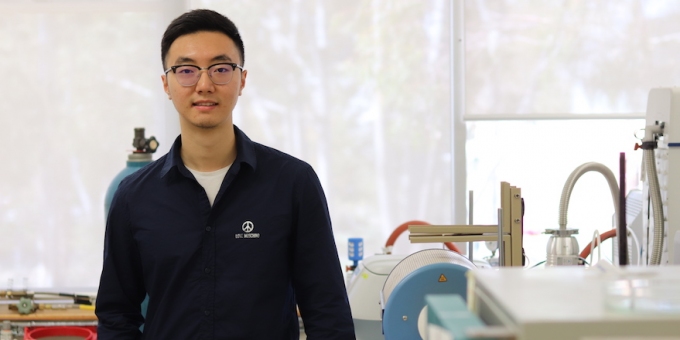Carbon fibre is an extremely strong, yet light weight material. This means it is attracting more and more applications – from bikes and tennis racquets to sports cars and planes.
Carbon fibre has also become a symbol of fashion, with its rippling black texture and expensive price tag. You will see it used in luxury phone cases, cars and watches.
However, materials researcher Di He (Andy) is more interested in what happens to this material after it’s life of luxury.
“Behind the fancy appearance, we usually forget that carbon fibre is a huge trouble-maker at its end-of-life”.
Andy says 95 per cent of carbon fibre ends up in landfill. Since it is not biodegradable, it will stay there forever.
“Unlike metals which can be melted and created into new products, carbon fibre cannot melt. This has created huge problems. In fact, we still don’t have an effective way to recycle and reuse carbon fibre.”
“The first carbon fibre airplanes will retire in the 2020s. If we still can’t recycle carbon fibre by then, this will create a tremendous amount of waste,” he said.
Andy is a PhD candidate at the Australian National University (ANU) Research School of Electrical, Energy and Materials Engineering. Originally from China, he completed his Bachelor’s degree in engineering at ANU, graduating with first-class honours.
Now working in the field of materials, he often sees a heavy emphasis on creation.
“We focus a lot on designing and producing high-quality materials. We haven’t been paying much attention to how we deal with these after their useful life,” said Andy.
Material engineering allows significant breakthroughs, but this approach can unintentionally lead to challenges for society, like the waste problem. That’s where modern day engineers and researchers, such as Andy, come in.
“I’m passionate about addressing real-world challenges by providing tangible solutions. Smart decisions in material engineering would produce materials that are fit for their applications, and more importantly, reduce their environmental impact at their end-of-life,” he said.
Andy’s research focus is to create a system that effectively recycles carbon fibre.
“I aim to improve the architecture of recycled carbon fibres, making them more useful. This would divert the material away from landfill and open up new applications for recycled carbon fibres.”
New applications for the resulting recycled material could also be found.
“If we can use strong but lightweight recycled carbon fibres in everyday cars, we can significantly improve the fuel economy. The cost would be a tiny fraction compared to virgin carbon fibre.”
Andy believes reducing waste, particularly from non-biodegradable materials, is an important factor in saving the planet.
“Reducing waste can ease the environmental stresses associated with waste disposal. Waste in landfill takes up lots of land, and hazardous waste leads to pollution to the environment, threatening the wellbeing of life on the planet.”
“You’d be amazed by how much value remains in materials even when they become waste. If we can recycle this into useful resources, we can reduce the amount of raw materials extracted from our planet.”
Andy hopes his research will have a positive impact on the world, by working with industry to create an effective recycling sector.
“After graduation, I’d like to work as a professional engineer and continue promoting waste reduction and recycling,” he said.
“This work can address the environmental challenges of waste disposal, and open up great opportunities for waste to become a really valuable resource.”

